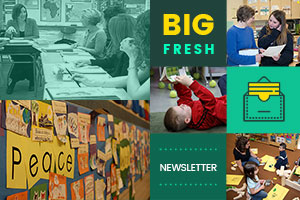Your calm mind is your ultimate weapon against your challenges.
Bryant McGill
Over the past few years I have shifted from drafting in documents saved on a single computer’s hard drive to using online word processing tools that can be accessed from any device. As it turns out, hitting save is part of my writing process. With online tools that automatically update and store drafts, there is no need to stop and click the save command. I miss it.
Something about the act of saving my recorded words gives me reason to pause. When I take time to pause, I look back over what I have written. I feel a sense of accomplishment. I decide what could be changed to strengthen my work. I have a direction for moving forward.
Hitting save is a lot like taking summer break. It is during summer when I take time to look back on my work in the classroom and take note of what went well. I also think about things I want to change. Ultimately, I enter the new school year with a new sense of direction.
Today in the midst of writing I stopped to hit the save key, only to realize the pause was unnecessary. Or was it? Although the pause was falsely prompted, the act of pausing still caused me to reread my words and reflect. So, maybe I do not need a real reason to stop and regroup.
Maybe I do not need to wait until summer to look back on my work and move forward with new direction. Maybe there are other ways to prompt myself to pause for reflection within the midst of the school year.
Every weekend, my husband and I have a standing writing group meeting with colleagues at a local coffee shop. We meet unapologetically, which means if we can be there, we are. When we are unable to make the meeting, the agreement is that we remain guilt-free. Of course, as it turns out, our get-togethers are so refueling that we often rearrange other obligations to avoid missing out.
The simple act of sharing writing goals, spending quiet time writing together, and breaking into spontaneous conversations offers a chance to process the work we are doing while we are still in the midst of it. Like hitting save while still drafting.
A year ago, I had the opportunity to participate in a book club with colleagues. We met once every few weeks before school to discuss the content of a professional book and its impact on our thinking. It was refreshing to listen to teachers in other subject areas discuss their work. Speaking with them caused me to review my own work through their eyes. I am certain I entered my classroom after those meetings with a renewed focus.
It is simple to stop briefly and take notice in the midst of our work. It doesn’t take more than a meeting with a writing group or book club. These are small acts, but I believe pausing for reflection is an act of saving our work, even if we are not clicking any keys in the process.
This week we pause to look at workshop routines. Plus more as always — enjoy!
Christy Rush-Levine
Contributor, Choice Literacy
Free for All
[For sneak peeks at our upcoming features, quotes and extra links, follow Choice Literacy on Twitter: @ChoiceLiteracy or Facebook: http://www.facebook.com/ChoiceLiteracy or Pinterest: http://pinterest.com/choiceliteracy/]
Shari Frost finds that the See-Think-Wonder activity is great to use as a “bell-ringer,” as well as throughout the day to promote deeper thinking and engagement:
http://www.choiceliteracy.com/articles-detail-view.php?id=2755
Ann Marie Corgill provides some guiding questions to help teachers figure out priorities in their schedules for daily routines:
http://www.choiceliteracy.com/articles-detail-view.php?id=1818
Justin Stygles questions his conferring routine during writing workshops, and the value of interrupting students early in the drafting process:
http://www.choiceliteracy.com/articles-detail-view.php?id=2516
For Members Only
Dana Murphy considers how teachers can make writing workshop routines more cozy and like writing at home:
http://www.choiceliteracy.com/articles-detail-view.php?id=2992
Ruth Ayres explains which workshop routines are essential for children who come to school bearing trauma:
http://www.choiceliteracy.com/articles-detail-view.php?id=2986
In this week’s video, Katrina Edwards demonstrates a read and think check-in from her first-grade classroom:
http://www.choiceliteracy.com/articles-detail-view.php?id=2725
Gretchen Schroeder finds new routines in her high school workshop means letting go of old expectations:
http://www.choiceliteracy.com/articles-detail-view.php?id=2616
In an encore video, Christy Rush-Levine helps her eighth-grade students launch the work period with a reflective question that sets a tone for productivity, and then returns to it throughout the morning during transition times:
http://www.choiceliteracy.com/articles-detail-view.php?id=2440
That’s all for this week!



